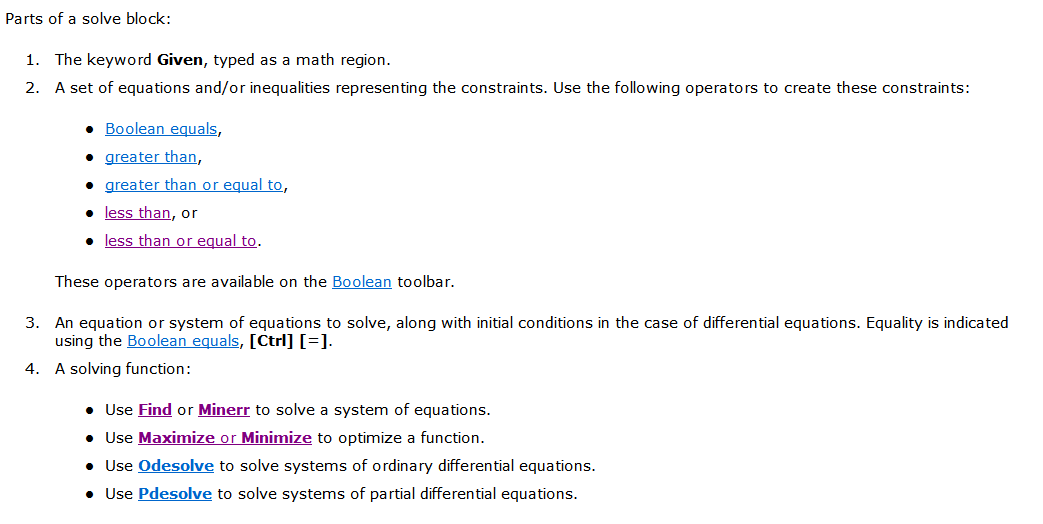Community Tip - Did you get called away in the middle of writing a post? Don't worry you can find your unfinished post later in the Drafts section of your profile page. X
- Subscribe to RSS Feed
- Mark Topic as New
- Mark Topic as Read
- Float this Topic for Current User
- Bookmark
- Subscribe
- Mute
- Printer Friendly Page
Solve blocks: what is a constraint?
- Mark as New
- Bookmark
- Subscribe
- Mute
- Subscribe to RSS Feed
- Permalink
- Notify Moderator
Solve blocks: what is a constraint?
I'm a little confused about the limits for solve blocks. In the snip from the MC 15 Help file below, it says the Levenberg-Marquardt solver is unconstrained. Yet it then says nonlinear systems can contain up to 200 constraints. Seems like a conflict if an equation is considered a constraint. I may have my own answer, but I would appreciate some confirmation.

So what does the Help file say about constraints? The next snip shows.

Note in particular item 2. The first sentence is ambiguous...it could mean that equations and inequalities are both constraints, or it could mean that inequalities are the constraints. Reading on, "Use the following operators to create these constraint:". The list includes the equals operator. So to me, this says that equations are included as constraints. So how can you solve for an unlimited number of variables with only 200 equations, or less if you've used inequalities also?
Then there is item 3. Again it mentions an equation or system of equations to solve. This suggests these equations are different from those in 2.
So, are we to conclude that the equations in 2 are like x=5 instead of x + y = 5 ? In other words, do the equations that involve only one variable and a constant get put into the constraint category that has a limit of 200?
- Labels:
-
Other
- Mark as New
- Bookmark
- Subscribe
- Mute
- Subscribe to RSS Feed
- Permalink
- Notify Moderator
Another possible definition for equality constraints.
An equality constraint is any equation in excess of the number of equations needed to solve for all of the variables, i.e. any equation in excess of the number of variables.
- Mark as New
- Bookmark
- Subscribe
- Mute
- Subscribe to RSS Feed
- Permalink
- Notify Moderator
An equality constraint is any equation in excess of the number of equations needed to solve for all of the variables, i.e. any equation in excess of the number of variables.
Can you give me an example where that doesn't simply result in an overdetermined system?
- Mark as New
- Bookmark
- Subscribe
- Mute
- Subscribe to RSS Feed
- Permalink
- Notify Moderator
A reactor has N species. N material balances are used to determine the mass fractions in the outlet stream. The sum of the fractions = 1 is an additional equation. This extra equation doesn't result in an unsolvable set yet I think it can help the optimizer stay in a feasible region while solving.
Granted, N-1 material balances could have been used + the sum = 1 equation. But that isn't as easy to do in vector notation.


